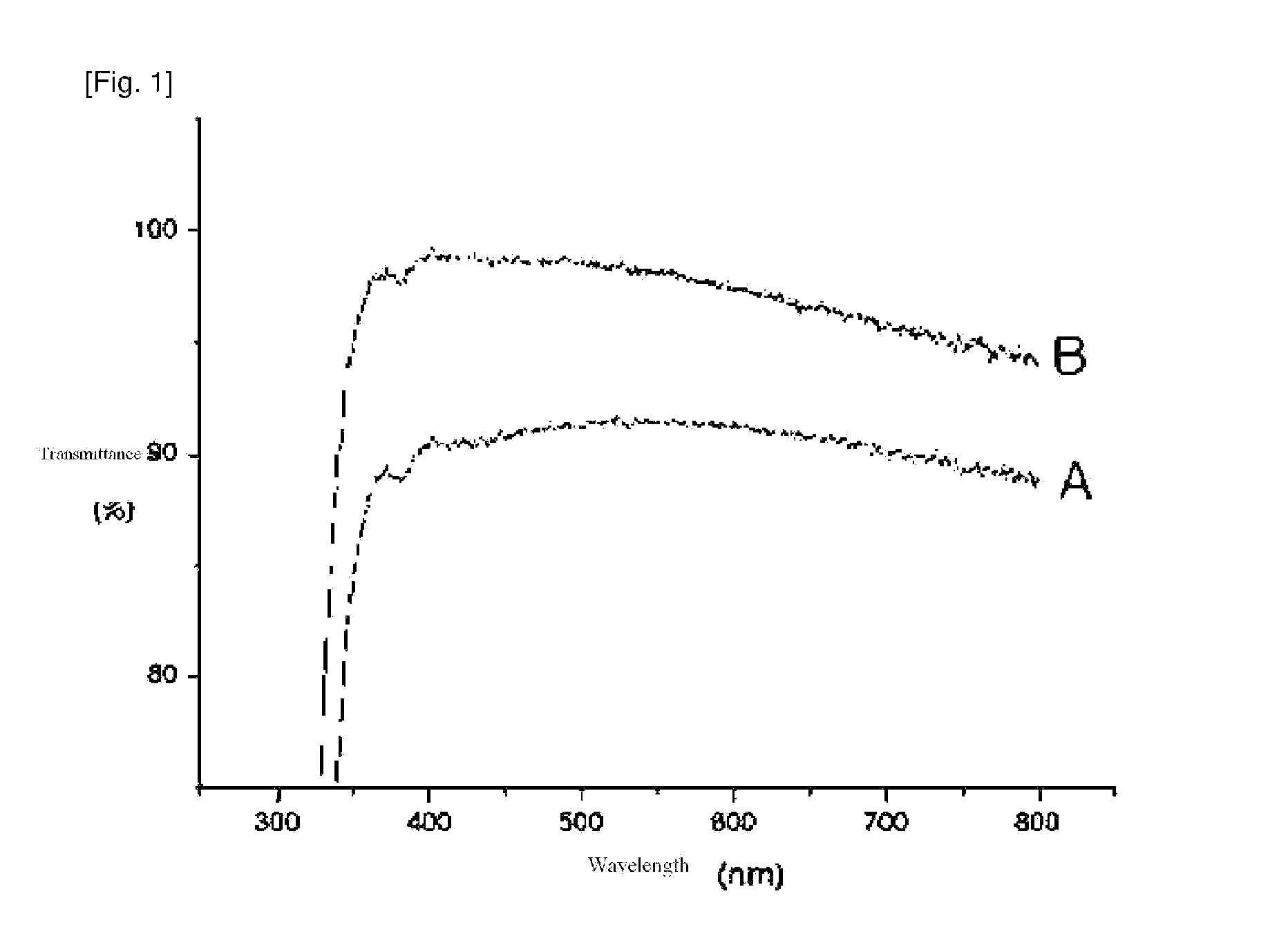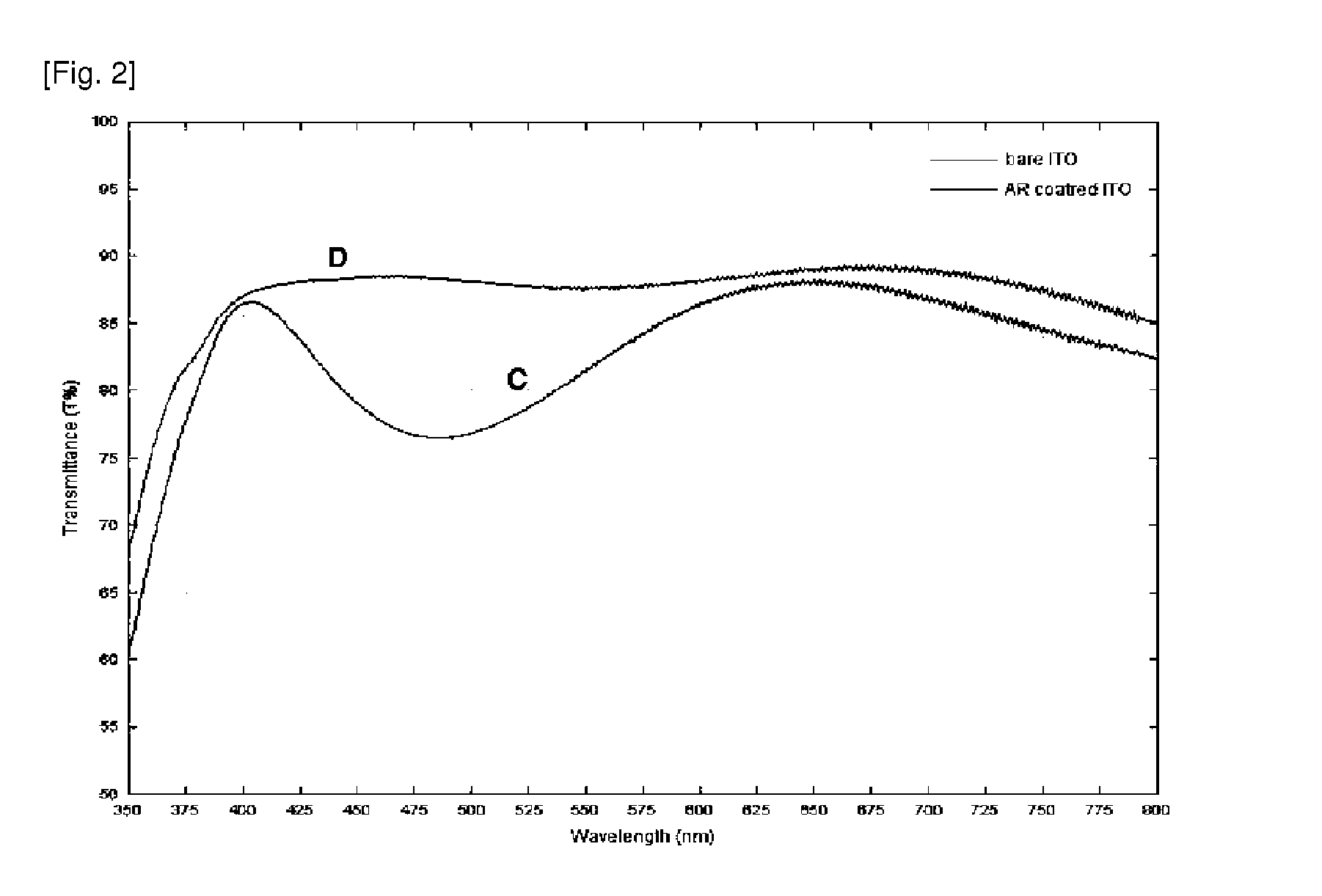Coating formulation affording antireflection effects on transparent substrate and method for manufacturing transparent substrate with antireflection function using said coating formulation
a technology of transparent substrate and coating formulation, which is applied in the direction of anti-reflective coatings, coatings, chemistry apparatus and processes, etc., can solve the problems of increasing manufacturing costs, affecting the effect of the coating, and unable to recognize the contents clearly displayed on the screen, so as to improve the adhesive force between the film and the substrate, the effect of simplifying the process and high transmittan
- Summary
- Abstract
- Description
- Claims
- Application Information
AI Technical Summary
Benefits of technology
Problems solved by technology
Method used
Image
Examples
embodiment 1
[0030]55 mL of distilled water was added to 45 mL of colloidal silica (Ace Hitech, Silifog) 10 weight % of which an average particle size was 6 nm, and mixture was treated for about 30 minutes by sonication for thereby manufacturing a silica dispersed solution of 4.5 weight % concentration. 0.14 g of NH4F was added to the dispersed solution, and a mole ratio of [NR4F] / [SiO2] to was set to 0.05, and the mixture was treated for about 30 minutes by sonication for thereby preparing a coating formulation. The coating formulation was treated in such a manner that part of the same was made in order to observe a gelation, pH and a size of silica particle, and the pH and the size of silica particle of the solution were measured by using a pH meter (Hanna HI221) and the particle is analyzer made by Malvern every 15 days.
[0031]The soda lime glass was well washed by using washing agent and was dipped in 1M of KOH solution for 5 hours and was washed by distilled water and was dried by blowing ai...
embodiment 15
[0038]55 mL of distilled water was added to 45 mL of colloidal silica (Ace Hitech, Silifog) 10 weight % of which an average particle size was 6 nm, and mixture was treated for about 30 minutes by an ultrasonic homogenizer for thereby manufacturing a silica dispersed solution of 4.5 weight % concentration. 0.3 g of NH4F was added to the dispersed solution, and the mixture was treated for about 30 minutes by sonication for thereby preparing a coating formulation.
[0039]The soda lime glass was well washed by using washing agent and was dipped in 1M of KOH solution for 4˜6 hours and was washed by distilled water and was dried by blowing air, not leaving any water marks. The prepared coating formulation was coated on the soda lime glass by the spin coating method at a speed of 800 rpm at 20° C. and 20% of relative humidity for thereby forming a silica coating film, and the silica coating film was dried for 3 hours at 120° C.
[0040]The transmittance and reflectance of the manufactured sampl...
embodiment 20
[0043]The embodiment was performed in the same manner as the embodiment 1 except that the back surface of the soda lime glass has a coating film with respect to the soda lime glass after the silica coating film was manufactured by the embodiment 1 for thereby forming the antireflection film at both surfaces. The transmittance is shown by the curve B in FIG. 1 about the visible light region. In this case, about 10% of transmittance in maximum was obtained as compared to the comparison example 2 in which the antireflection film was not formed.
PUM
| Property | Measurement | Unit |
|---|---|---|
| particle size | aaaaa | aaaaa |
| mole ratio | aaaaa | aaaaa |
| mole ratio | aaaaa | aaaaa |
Abstract
Description
Claims
Application Information
 Login to View More
Login to View More - R&D
- Intellectual Property
- Life Sciences
- Materials
- Tech Scout
- Unparalleled Data Quality
- Higher Quality Content
- 60% Fewer Hallucinations
Browse by: Latest US Patents, China's latest patents, Technical Efficacy Thesaurus, Application Domain, Technology Topic, Popular Technical Reports.
© 2025 PatSnap. All rights reserved.Legal|Privacy policy|Modern Slavery Act Transparency Statement|Sitemap|About US| Contact US: help@patsnap.com



